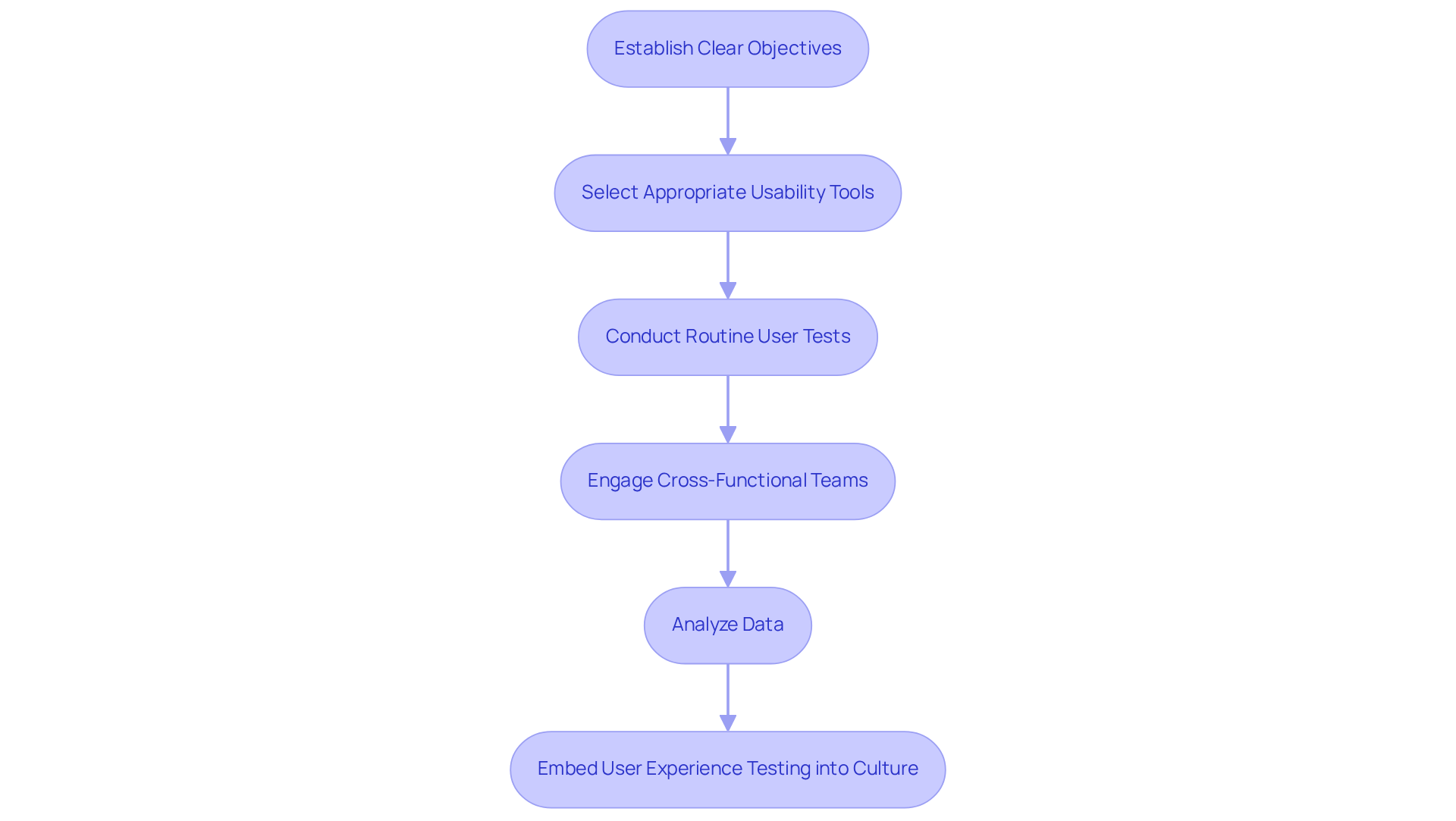
Overview
Usability tools are indispensable for the profitability of DTC brands, as they significantly enhance user experience by identifying and addressing pain points throughout the customer journey. This proactive approach not only reduces cart abandonment but also drives higher conversion rates. Evidence presented in the article underscores this assertion, revealing that effective usability practices can lead to an astonishing 400% increase in conversion rates. Such data clearly illustrates the direct financial benefits of investing in user-centric design strategies. By prioritizing usability, DTC brands position themselves to thrive in a competitive landscape.
Introduction
In the competitive arena of direct-to-consumer (DTC) brands, the user experience is pivotal to profitability. Usability tools—such as heatmaps and feedback surveys—provide invaluable insights into customer interactions. These tools enable brands to fine-tune their digital interfaces, maximizing engagement. Yet, with nearly 70% of online shoppers abandoning their carts, a pressing question arises: how can DTC brands effectively leverage these tools to enhance user satisfaction and drive significant revenue growth?
Understand the Role of Usability Tools in Enhancing User Experience
A usability tool is essential for enhancing the experience of individuals by providing critical insights into their interactions with a website or application. These usability tools, including heatmaps, session recordings, and feedback surveys, serve as a usability tool that empowers companies to observe user behavior in real-time. For instance, heatmaps highlight which areas of a webpage capture the most attention, while session recordings reveal where users encounter difficulties. By understanding these interactions, DTC brands can implement informed changes to their design and functionality, making their offerings a more effective usability tool for users. This proactive strategy not only elevates user satisfaction but also decreases bounce rates, ultimately leading to and profitability.
Incorporating a usability tool into the design process is vital for identifying and addressing user experience issues before they escalate into significant barriers to conversion. As noted by UX professionals, effective user experience can enhance e-commerce conversion rates by as much as 400%, underscoring the financial benefits of investing in user-centric solutions. Furthermore, with 70% of online shoppers abandoning their carts, the urgency for DTC brands to effectively leverage a usability tool cannot be overstated. Proactively tackling user experience challenges is essential, as rectifying issues during development costs ten times more than addressing them in the design phase.
In a competitive landscape, the importance of a usability tool in fostering long-term customer loyalty and enhancing engagement is paramount. By prioritizing these tools, brands position themselves for sustained success in the digital marketplace.

Explore the Benefits of Usability Tools for DTC Brand Profitability
The advantages of functional resources extend far beyond mere consumer satisfaction; they are crucial for enhancing the profitability of direct-to-consumer companies. By leveraging these tools, companies can pinpoint specific pain points in the user journey that may deter potential customers.
Research indicates that nearly 70% of online companies encounter challenges due to insufficient user experience, underscoring the imperative for organizations to address these issues. For instance, a study conducted by the Baymard Institute revealed that 68.53% of online shopping carts are abandoned. By tackling these challenges with a usability tool, companies can significantly reduce cart abandonment rates and boost conversion rates.
Parah Group's case studies clearly illustrate this impact:
- One clothing label experienced a remarkable 35% increase in conversion rates after implementing strategic adjustments, such as redesigning the homepage to highlight social proof and optimizing product pricing.
- Another cleaning product brand achieved an impressive 80% rise in average order value (AOV) by introducing bundles and multi-packs to encourage larger purchases.
Furthermore, user experience resources facilitate A/B testing, allowing brands to experiment with various design elements and determine which variations yield the highest engagement and sales. This data-driven approach not only enhances the user experience but also maximizes AOV, ultimately driving increased revenue.
The potential for a 35.26% rise in conversion rates through improved checkout design, as highlighted by the Baymard Institute, underscores the financial impact of user-friendly solutions. Thus, the strategic implementation of a usability tool can , converting potential losses into substantial gains.

Assess the Risks of Ignoring Usability Testing in DTC Strategies
Disregarding user experience evaluation in DTC strategies can lead to severe repercussions for companies. Poor usability results in frustrating experiences, causing high bounce rates and lost sales opportunities. For example, a website that is difficult to navigate or a cumbersome checkout process will likely prompt potential customers to abandon their carts in favor of competitors with more user-friendly interfaces.
Moreover, negative consumer experiences can damage a company's reputation, leading to reduced customer loyalty and trust. Research indicates that:
- 88% of online consumers are less likely to return to a site after a bad experience.
- 79% of users will not return due to performance issues such as slow-loading pages.
In an environment where customer acquisition costs are escalating, retaining existing customers through positive experiences is more critical than ever. Thus, neglecting as a usability tool jeopardizes not only short-term sales but also long-term brand sustainability and growth.
Parah Group, a specialist in Conversion Rate Optimization (CRO), emphasizes that a continuous CRO program—integrating a usability tool for user experience testing—facilitates data-driven decisions that directly support business expansion while reducing customer acquisition costs and enhancing profitability.
As one UX expert noted, 'User testing is not merely about detecting and resolving issues; it has a direct and significant effect on user retention.' This underscores the imperative for companies to prioritize user-friendliness in their strategies, especially when partnering with an expert agency like Parah Group.

Integrate Usability Tools into Your DTC Brand Strategy for Optimal Results
To effectively incorporate into your DTC brand strategy, a systematic approach aligned with your business goals is essential. Begin by establishing clear objectives for your testing, such as improving conversion rates or enhancing participant satisfaction. The selection of appropriate usability tools is crucial; for instance, Hotjar serves as an effective usability tool for heatmaps, while UserTesting provides invaluable feedback insights.
Conduct routine user tests throughout the design process rather than solely at the conclusion, allowing for early detection and resolution of issues. Engaging cross-functional teams in the testing process enriches the insights gathered, fostering a more comprehensive understanding of user needs. Following user experience tests, meticulously analyze the data to inform design choices and continuously refine your website or application.
By embedding user experience testing into your company's culture, you cultivate a user-focused approach that not only enhances engagement and loyalty but also significantly boosts profitability. Statistics reveal that an effective usability tool can elevate conversion rates by up to 400%, highlighting its vital role in achieving your brand's financial objectives.

Conclusion
Emphasizing the critical role of usability tools in enhancing the profitability of direct-to-consumer (DTC) brands reveals a transformative approach to user experience. By employing these tools, brands gain invaluable insights into user interactions, leading to informed design decisions that improve customer satisfaction, drive conversion rates, and ultimately, foster financial success.
The article outlines several compelling arguments highlighting the necessity of usability tools. These include:
- Their ability to identify pain points in the user journey
- Significantly reduce cart abandonment rates
- Demonstrate the proven correlation between enhanced user experience and increased sales
Case studies illustrate tangible results, including substantial increases in conversion rates and average order values following strategic adjustments informed by usability testing.
In the competitive digital landscape, the long-term sustainability of DTC brands hinges on their commitment to user-centric strategies. Ignoring usability testing can lead to lost sales and diminished brand loyalty. Therefore, integrating usability tools into brand strategies is not merely beneficial; it is essential for fostering customer retention and maximizing profitability. Brands must prioritize these tools to exceed user expectations, ensuring a thriving market presence.
Frequently Asked Questions
What is the role of usability tools in enhancing user experience?
Usability tools are essential for improving user experience by providing insights into user interactions with websites or applications. They help companies observe user behavior in real-time, allowing for informed changes to design and functionality.
What types of usability tools are commonly used?
Common usability tools include heatmaps, session recordings, and feedback surveys. Heatmaps show which areas of a webpage attract the most attention, while session recordings reveal where users face difficulties.
How do usability tools impact e-commerce conversion rates?
Effective user experience, supported by usability tools, can enhance e-commerce conversion rates by as much as 400%, highlighting the financial benefits of investing in user-centric solutions.
Why is it important for DTC brands to use usability tools?
DTC brands must use usability tools to address user experience issues proactively, as 70% of online shoppers abandon their carts. Tackling these challenges early can prevent significant barriers to conversion and improve overall user satisfaction.
What are the cost implications of addressing user experience issues during development versus the design phase?
Rectifying user experience issues during development can cost ten times more than addressing them in the design phase, making it crucial to incorporate usability tools early in the design process.
How do usability tools contribute to long-term customer loyalty and engagement?
By prioritizing usability tools, brands can enhance user experience, which fosters long-term customer loyalty and engagement, positioning themselves for sustained success in the digital marketplace.
FAQs











